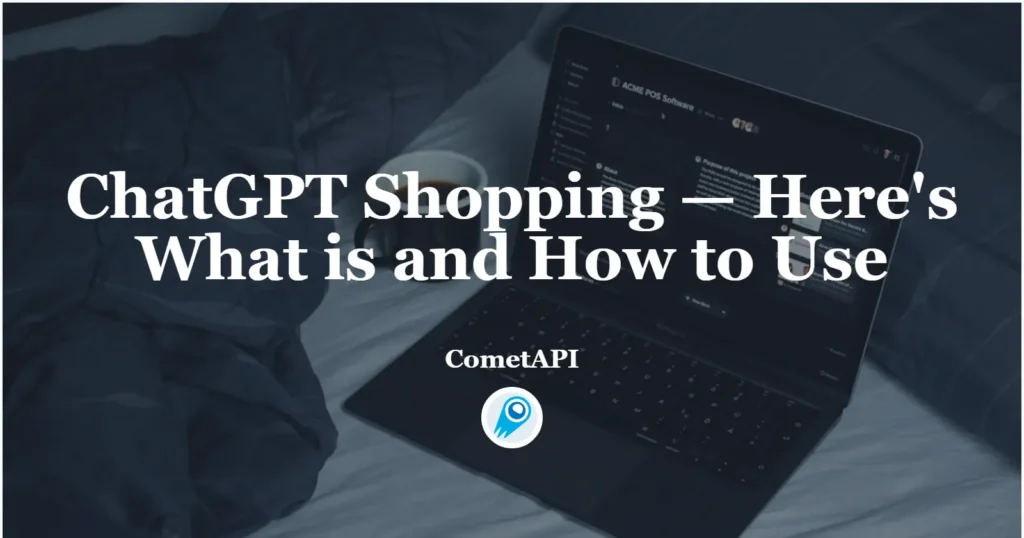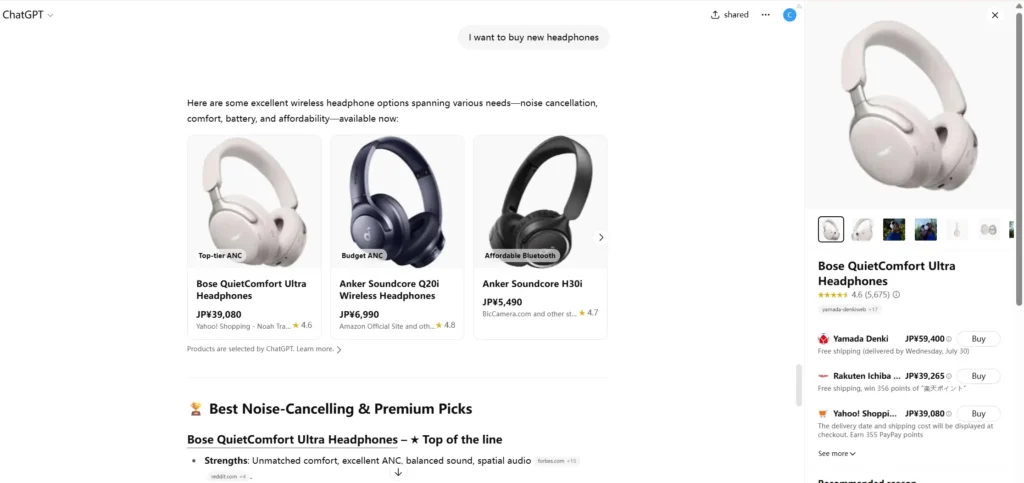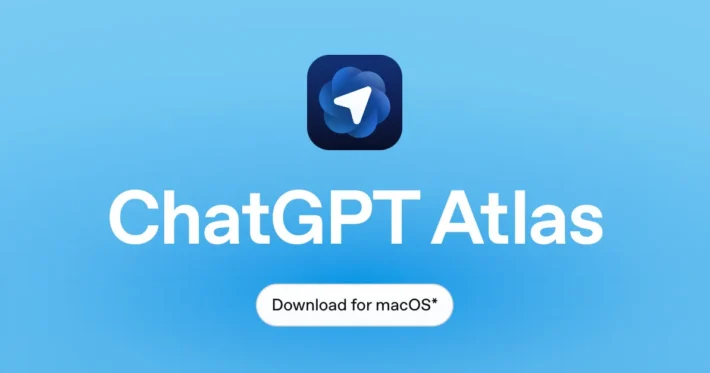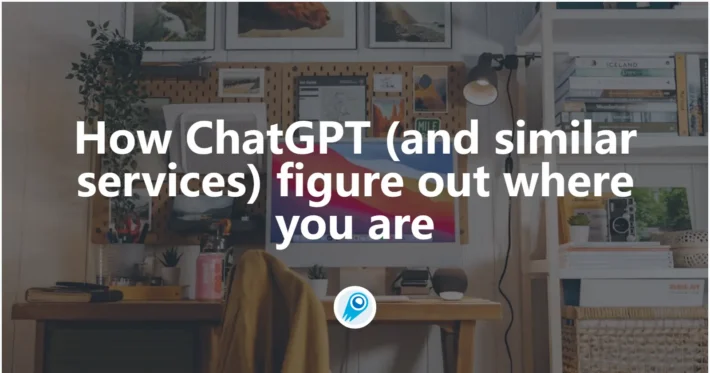ChatGPT Shopping — Here’s What is and How to Use!

With the rapid evolution of large language models (LLMs), ChatGPT has moved from a purely conversational AI to a fully capable shopping assistant. Over the past two months, OpenAI has rolled out native in‑chat shopping features—powered by partnerships with Shopify, Visa, and major retailers—allowing users not only to explore and compare products, but to complete purchases without leaving the chat interface. This article examines what ChatGPT can buy for you, how it works under the hood, its advantages over traditional e‑commerce, and what both consumers and merchants need to know to make the most of this emerging “conversational commerce” paradigm.
What new shopping capabilities does ChatGPT offer?
Conversational product discovery
Rather than typing keywords into a search engine, users can now ask ChatGPT natural‑language questions like “Show me the best wireless earbuds under $100 with noise cancellation” and receive a curated list of products—complete with images, specifications, pricing, and reviews—in seconds. This “shopping mode” launched in late April 2025 and sources real‑time data directly from merchant catalogs and data partners, eliminating out‑of‑date listings and reducing decision fatigue .
In‑chat checkout and payment integration
Beyond recommendations, ChatGPT now supports an end‑to‑end purchase flow. Thanks to a native integration discovered in ChatGPT’s JavaScript bundle (with Shopify variable names identified as early as April 20, 2025), users can add items to a virtual cart and complete checkout—all within the chat window . Visa has also announced plans to embed its payment network directly into AI platforms, enabling payment details to be securely tokenized and reused across future chats .
Product Carousels and Recommendations
Rather than showing plain text links, ChatGPT presents visually rich product carousels that draw from both editorial sources (e.g., WIRED buying guides) and real‑time web data (e.g., retailer inventories and customer reviews). The model aggregates user-specified preferences—such as price range or style—and previous conversation context (e.g., “I hate cigarette‑smoke scents”) to tailor recommendations . According to OpenAI’s Adam Fry, ChatGPT already handles over a billion web searches per week, many of which relate to shopping; the new feature simply formalizes and enriches that use case.
How does ChatGPT integrate with e‑commerce platforms?
Redirection to Merchant Sites
Despite integrating “Buy” buttons, ChatGPT does not process payments directly. Instead, clicking a shopping button redirects users to the merchant’s website, where the transaction is completed using the retailer’s native checkout system . This design both leverages existing, secure payment infrastructures and sidesteps the need for OpenAI to handle sensitive financial data directly.
Shopify partnership and native flows
OpenAI’s strategic collaboration with Shopify is at the heart of the in‑chat shopping experience. Merchant consent, real‑time inventory, pricing updates, promotions, order sync, and fulfillment tracking are all handled through Shopify’s APIs and webhooks. This tight coupling ensures product availability and pricing in ChatGPT mirror the merchant’s live store, solving the “out‑of‑stock” and “stale price” issues common to third‑party marketplaces.
Third‑party retailer links and affiliate models
In addition to Shopify, ChatGPT aggregates offerings from major retailers—Amazon, Best Buy, Walmart—via deep‑web product feeds and affiliate integration. Early experiments surface “Buy Now” buttons that redirect to the retailer’s checkout page, with OpenAI exploring affiliate‑revenue sharing models to monetize these referrals. While OpenAI currently does not place paid ads in shopping results, industry observers expect a shift toward hybrid monetization (affiliate fees, sponsored placements) once core user experience is proven .
What distinguishes ChatGPT shopping from traditional e‑commerce?
Personalized, ad‑free recommendations
Unlike keyword‑based search engines, ChatGPT shopping emphasizes personalization through context‑aware dialog. If a user refines a query (“What if I want something eco‑friendly?”), the model instantly adjusts suggestions. Importantly, OpenAI has positioned this feature as “recommendation‑first,” with no ad placements to date—prioritizing user trust and perceived neutrality.
Trust and data accuracy
Real‑time syncing with merchant systems via Shopify and vetted data aggregators ensures that product specifications, stock levels, pricing, and shipping estimates remain accurate. This trustworthiness is critical: 78% of online shoppers cite “out‑of‑stock” errors and stale pricing as the biggest pain points in e‑commerce, and AI models trained solely on web‑scraped data have historically struggled to keep up .
How secure and private is shopping via ChatGPT?
Data handling and payment info security
To process payments, ChatGPT leverages end‑to‑end encryption and tokenization protocols. Visa’s integration allows users to vault their payment credentials once, then authorize transactions with a simple chat command or biometric confirmation on their device. All personally identifiable information (PII) and payment data are stored on PCI‑compliant servers under merchant control, not within OpenAI’s systems, mitigating breach risks .
Trust barriers and countermeasures
Despite robust security measures, consumer trust remains a key hurdle. A recent Axios survey found that 52% of AI shopping users worry about unintended charges or data misuse. To address this, OpenAI has introduced transparency controls—users can view all pending charges before approval, revoke vendor payment access at any time, and review detailed order histories within the chat interface. These safeguards aim to build confidence in a nascent transactional channel .
What are the technical underpinnings enabling ChatGPT to shop?
Plugins and API Integrations
ChatGPT’s shopping feature builds on the existing plugins framework, which allows third‑party services to extend the model’s capabilities. Retailers and affiliate networks can develop plugins or APIs that provide up‑to‑date product catalogs, pricing, and availability. When a shopping query is detected, ChatGPT invokes these plugins to fetch live data, assembles a ranked list of options, and formats the results into an interactive carousel.
AI‑driven Personalization
The core language model (e.g., GPT-4o or GPT‑4o‑mini) applies advanced personalization by recalling user preferences specified earlier in the conversation—like preferred brands, budget constraints, or stylistic tastes—and factoring in sentiment cues. For instance, if a user previously expressed a dislike for “clown costumes,” ChatGPT will omit such items from its list of Halloween recommendations for pet costumes . This dynamic context‑aware filtering represents a step beyond static “best of” lists, aligning suggestions closely with individual needs.
How can businesses and users enable and optimize ChatGPT shopping?
For merchants: integration and API setup
Merchants on Shopify can opt into ChatGPT Shopping via their admin dashboard. Enabling the “Conversational Commerce” toggle publishes their product catalog to OpenAI’s data aggregator, along with API keys for order creation and fulfillment updates. Best practices include:
- Maintaining real‑time inventory feeds to prevent overselling
- Tagging products with attributes like “eco‑friendly,” “on sale,” or “fast shipping” to enhance AI filtering
- Monitoring conversational analytics in Shopify’s analytics suite to see which queries drive the most conversions .
Larger retailers and direct‑to‑consumer brands can implement the ChatGPT Shopping SDK (released May 2025) to customize the chat UI, loyalty rewards integration, and cross‑platform analytics.
For users: accessing shopping features
Access to ChatGPT shopping is available on both web and mobile apps. Users simply start a new conversation with prompts like “I want to buy…” or select the “Shopping” mode from the sidebar. Once enabled, they can:
- Browse: “Show me recommended laptops under $1,500.”
- Refine: “Filter to models with 16 GB RAM and SSD storage.”
- Compare: “Compare Battery life between these two.”
- Buy: “Add the first one to my cart and checkout.”
For payment, users link a Visa, Mastercard, or digital wallet once; subsequent purchases use a secure token, requiring only a simple confirmation phrase (e.g., “Confirm purchase of $299.99”) .

The advent of in‑chat shopping marks a turning point: AI’s ability to not only inform but to transact transforms ChatGPT from a passive assistant into an active agent of commerce. By blending natural language understanding with secure payment flows and real‑time merchant integrations, ChatGPT is poised to reshape how consumers discover, compare, and purchase products—and how businesses engage with customers in an increasingly conversational world.
Getting Started
CometAPI provides a unified REST interface that aggregates hundreds of AI models—under a consistent endpoint, with built-in API-key management, usage quotas, and billing dashboards. Instead of juggling multiple vendor URLs and credentials.
While waiting, Developers can access O4-Mini API ,O3 API and GPT-4.1 API through CometAPI, the latest models listed are as of the article’s publication date. To begin, explore the model’s capabilities in the Playground and consult the API guide for detailed instructions. Before accessing, please make sure you have logged in to CometAPI and obtained the API key. CometAPI offer a price far lower than the official price to help you integrate.
Use CometAPI to access chatgpt models, start shopping!



